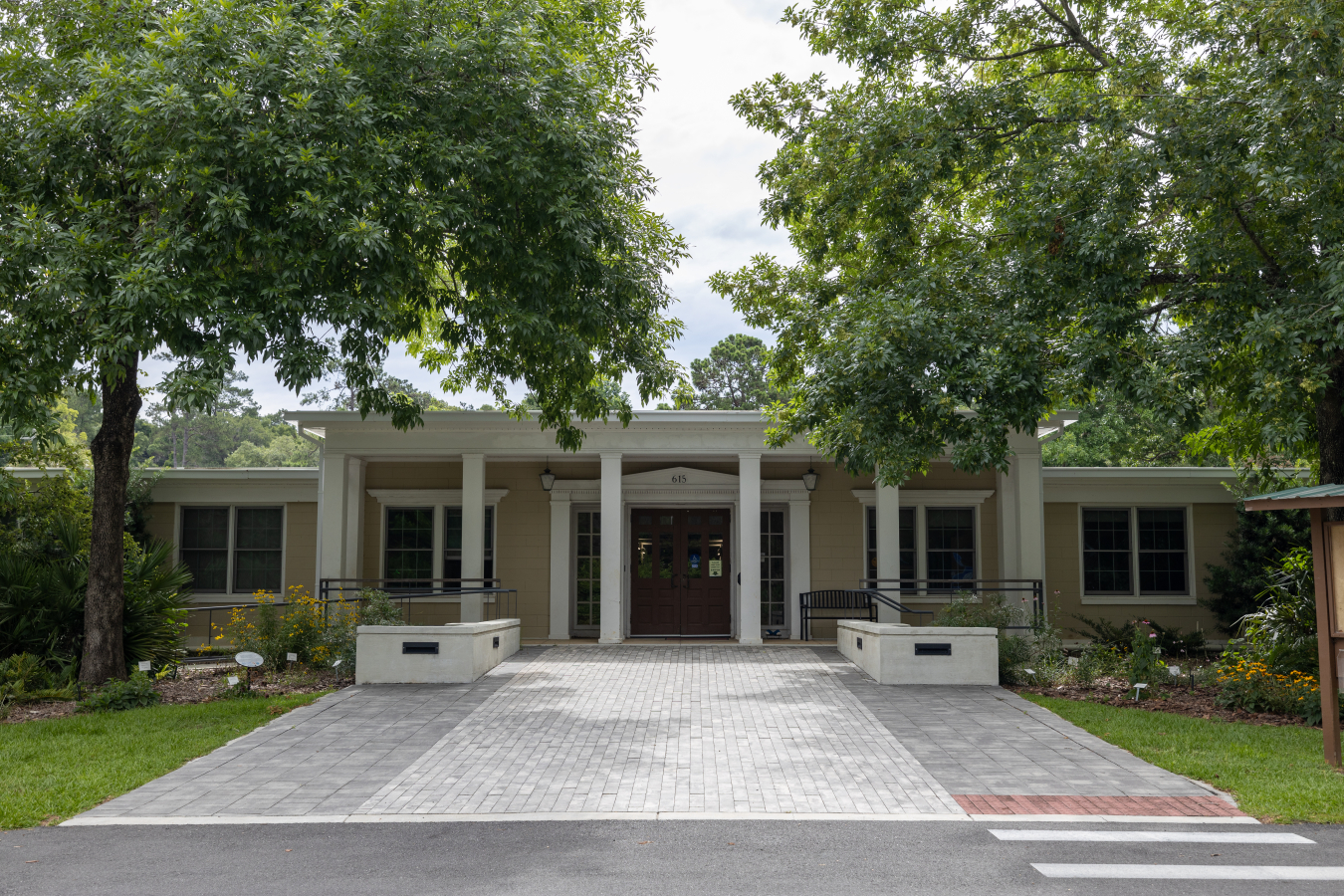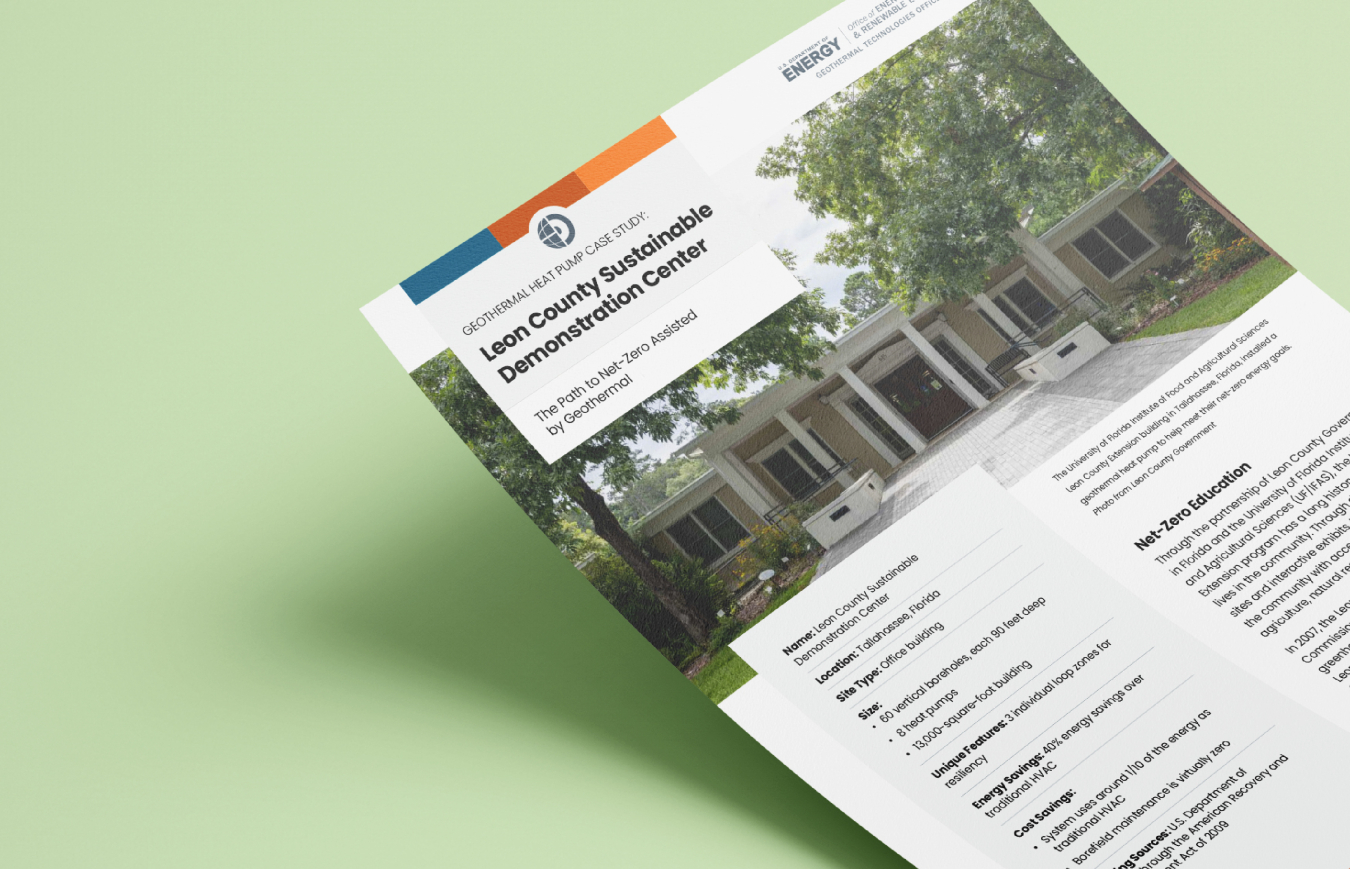
The University of Florida Institute of Food and Agricultural Sciences Leon County Extension building in Tallahassee, Florida, installed a geothermal heat pump to help meet their net-zero energy goals. Photo from Leon County Government
Fast Facts
Location: Tallahassee, Florida
Size:
- 60 vertical boreholes, each 90 feet deep
- 8 heat pumps
- 13,000-square-foot building
Unique Features:
- 3 individual loop zones for resiliency
Download the full case study for additional fast facts.
Educating the Community on Net-Zero Energy
Through the partnership of Leon County Government in Florida and the University of Florida Institute of Food and Agricultural Sciences (UF/IFAS), the Leon County Extension program yielded a long history of improving lives in the community. Through demonstration sites and interactive exhibits, this program provides the community with access to critical knowledge in agriculture, natural resources, and life sciences.
In 2007, the Leon County Board of County Commissioners formalized a priority of reducing greenhouse gas emissions throughout the county. Leon County Government identified the UF/IFAS Leon County Extension office as an opportunity to use the 1962 cinderblock structure as a demonstration building to educate the community about multiple sustainable energy systems.
Geothermal System Completed in Just Six Weeks
A team from Leon County Government and consultants began to identify sustainable energy projects to minimize peak energy demand and lower utility costs in the building, including a solar photovoltaic (PV) system, lighting retrofit, thermostat setbacks, and a geothermal heat pump (GHP) system. The Leon County Extension Program received funding for the project from Leon County Government as well as grants, such as $178,000 in state-allocated federal funding from the American Recovery and Reinvestment Act of 2009.
The geothermal heat pump system took six weeks to complete and was finished in 2012. The system includes a closed-loop geothermal borefield with 60 vertical wells around 90 feet deep with three individual loop zones for resiliency. If one loop needs repairs, the other two will continue to operate. The borefield is also used as an educational event parking overflow that remains pervious to rainwater.
Eight geothermal heat pumps replaced nine traditional air conditioning condensers and allow the system to remove or recover heat, depending on the season. Most of the geothermal heat pump system’s heaviest work happens during the hot and humid northern Florida summer months.
The building features an educational kitchen for visitors to learn about food safety and staff to prepare food for low-income/fixed-budget families as well as meals for attendees at youth summer camps. Recovered waste heat from the geothermal heat pump system supplies this kitchen with hot water.
Teaching Future Generations About Net-Zero Energy. Student visitors learn how the stable ground temperature can offset energy costs through geothermal. Photo from Leon County Government
Energy Savings:
- 40% energy savings over traditional HVAC
Cost Savings:
- System requires about 1/10 of the maintenance costs as traditional HVAC
- Borefield maintenance is virtually zero
Funding Sources:
- U.S. Department of Energy through the American Recovery and Reinvestment Act of 2009
Past Is Prologue: Retrofit Planning and Design Impacted by History
The geothermal heat pump system only supplies about 50% of the 13,000 square foot building’s conditioned air. The reason for this can be explained by the building’s not-too-distant past.
As with any retrofit to an existing structure that has been used for decades, mysteries and vital historical elements surface. This was no different when the team began to plan and design air distribution for their geothermal heat pump system. While reviewing the original plans from 1962, the team realized that the building was originally constructed as a racially segregated building, even featuring segregated air conditioning infrastructure.
The existence of two mechanical rooms is unusual, as is the segmented air supply system. The separate HVAC systems influenced the decision to allocate the geothermal heat pump system to about 50% of the building; a traditional natural gas HVAC system serves the other half. The on-site solar PV system offsets the remaining electricity consumption to maintain net-zero energy goals.
Geothermal Heat Pump Equals Less Energy and Less Maintenance
Fast forward to the present day and the geothermal heat pump system continues to reduce energy and maintenance costs. The system uses 1/10 the energy of a traditional HVAC system, and mechanical maintenance costs are similar for the geothermal heat pump and HVAC systems. However, the geothermal borefield has virtually zero maintenance except for an annual fluid test. In fact, the County’s training of new maintenance staff focuses primarily on conventional HVAC because upkeep on the geothermal heat pump borefield is negligible.
“The building continues to operate as a net-zero facility even as we’ve doubled the number of staff people that occupy the site. The geothermal system has been a key part of infrastructure allowing the building to stand up to evolving demands.”
Maggie Theriot; Director of the Office of Resource Stewardship; Leon County, Florida
Contacts:
For questions about this case study, contact Maggie Theriot, theriotm@leoncountyfl.gov.
For any website technical issues or general questions about geothermal heat pumps, contact DOE.Geothermal@ee.doe.gov.
Printable Version
Download the printable Leon County case study or visit the Geothermal Heat Pump Case Studies page to see more examples of geothermal heat pumps in action.


